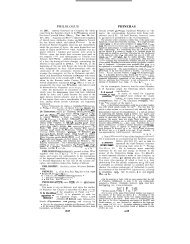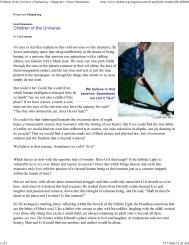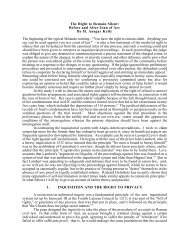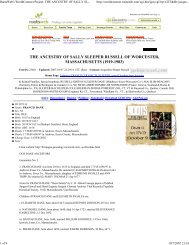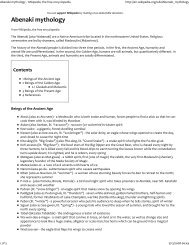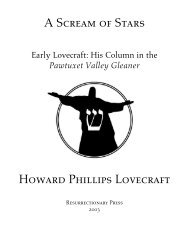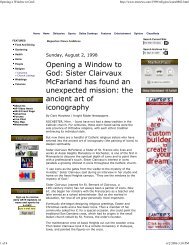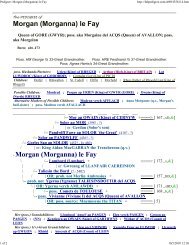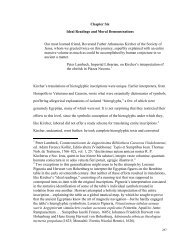sefi;g:v. - A Kabbalist walks into a bar, and the
sefi;g:v. - A Kabbalist walks into a bar, and the
sefi;g:v. - A Kabbalist walks into a bar, and the
Create successful ePaper yourself
Turn your PDF publications into a flip-book with our unique Google optimized e-Paper software.
SEDUCERS<br />
Maasias, an ancestor of BARUCH [~.a.] (Bar. 1 I); cp ' Zedekiah<br />
b. Maaseiah ' Jer. 29 ZIJ z. In Bar. 18 ; elsewhere called ZEDEKIAH, I.<br />
SEDUCERS, RV ' Impostors' (roHTac), 2 Tim. 3 13.<br />
See MAGIC, 4.<br />
SEER(;Igl, I S.99; nfn, 2S.2411); PROPHET,<br />
J 5.<br />
4343<br />
SELA<br />
SEIR, MOUNT (7*& 117; opoc accap PI,<br />
0. accapsc [Babl, 0. CHEIP [A], 0. ciaip [L]), one of<br />
<strong>the</strong> l<strong>and</strong>marks on <strong>the</strong> boundary between Judah <strong>and</strong><br />
Benjamin (Josh. 15 io), between Kirjath-jearim <strong>and</strong><br />
CHESALON [q. v.], <strong>and</strong> <strong>the</strong>refore in <strong>the</strong> neighbourhood<br />
of <strong>the</strong> rocky point of S&is, z m. W. by S. from b7aryeteGknub<br />
(so Robinson). With Saris may be identified<br />
SEGUB (XI@, CsroyB). I. b. Hezron; fa<strong>the</strong>r of<br />
JAIR [q...] (I Ch. 2~1f., cspoyx [B]). See CALEB-<br />
EPHRATAH, REUBEN, 5 11.<br />
2. The youngest son of HIEL [q.v.] (I K. 1634 ; Kr.<br />
Y:?; S;youp [B ; om. L]). Cp REUBEN, J 11. In d<br />
<strong>the</strong> Sores of 6, Josh. 1560 (ewpqs [B], crwpqs [A], -as<br />
[L]) ; see Buhl, PuL 91 167, <strong>and</strong> BENJAMIN, JUDAH.<br />
SEIRAH, but AV Seirath (ilp?*@;l), <strong>the</strong> place to<br />
which Ehud fled, where he 'blew <strong>the</strong> trumpet in <strong>the</strong><br />
hill country of Ephraim' (Judg. 326, ceTslpwea [Bl,'<br />
of Josh. 626 it may be his name that is rendered<br />
GrarwOCvn ; <strong>the</strong> translator apparently misread SIIU<br />
(Aram. ' to save ').<br />
On <strong>the</strong> name see NAMES 0 57 <strong>and</strong> for S. Ar. analogies,<br />
Hommel S22da&. AZtertZnr~~ (1849) 21. But <strong>the</strong> <strong>the</strong>ory that<br />
it is an e;hnic like Jair, Hezron, <strong>and</strong> Machir is attractive. 63<br />
in I Ch. 2 213 implies 191@, <strong>and</strong> this comes probably by transposition<br />
from 1i.ie (cp SERUG). Abiram, <strong>the</strong> bro<strong>the</strong>r of z, also<br />
probably hears an ethnic name. ' Ram,' if not also <strong>the</strong> fuller<br />
form Ahiram, comes (like 'Jericho ') from nny= suDni* (Che.).<br />
See Crit. Bi6.<br />
SEIR (7*@), <strong>the</strong> reputed ancestor of <strong>the</strong> Horites<br />
(Gen. 3620f. I Ch. 138f:). See SEIR, MOUNT.<br />
SEIR, MOUNT (V&, ei<strong>the</strong>r lit. 'hairy' [Lag.<br />
064~s. 921, or trop. 'overgrown' [NO. ZDMG40165 n. a]; Q<br />
always mpp, except Josh. 11 17 q 1 c a ~ [A] ; 12 7 met a [AF]<br />
auurrrpa [Ll : I Ch. 1 8 @?BL~ [A] ; kzek. 258 [om. dQ] ; Dt:<br />
passim, Ch. [except I 8h. 1381 U L ~ [L]). Y<br />
The name of a mountain district occupied by Esau <strong>and</strong> <strong>the</strong><br />
Edomites, Josh. 24 4 (E), Gen. 368f: (P), Dt. 2 5 etc., but by <strong>the</strong><br />
Horites in Gen. 146 (on text see especially Buhl, Edomifer, 28).<br />
The name ' l<strong>and</strong> of Seir ' (l*@ p!) also appears in Gen. 32 4<br />
u) 36 30(P ; where, however, @ has cSop [ADEL, B lacking])<br />
<strong>and</strong> (often) simply ' Seir ' Judg. 5 4 Gen. 33 14 16 u), Nu. 24 1:<br />
UE : where, however, @'has 9uau [BAFLI), Dt. 144 etc.<br />
The mountain region of Seir (mod. ef-fuvrih) extends 15<br />
or 20 m. E. from <strong>the</strong> 'Arabah (S. from <strong>the</strong> Dead Sea),<br />
which it skirts nearly to <strong>the</strong> Gulf of'Akaba (<strong>the</strong> terms<br />
' l<strong>and</strong> of Seir ' <strong>and</strong> ' Seir,' are sometimes applied to <strong>the</strong><br />
plateau W. of <strong>the</strong> 'Arabah) ; Zimmern ( W 6157 n. 13)<br />
doubtfully suggests a connection with <strong>the</strong> district of<br />
3eri mentioned (with Gintikirmil) in an Amarna letter<br />
from Jerusalem (Wi. KB518z [B 1051 26). On early<br />
traces of <strong>the</strong> name Seir, <strong>and</strong> on its meaning, see EDOM,<br />
5s 2, 3. F. B.<br />
' Edom' <strong>and</strong> ' Seir ' are terms which are often used<br />
interchangeably as <strong>the</strong> designation of a region occupied<br />
ceoipwea [AI. cHpW€Ia[L]). The name has greatly<br />
puzzled critics2 Winckler (AZttest. Unt. 5 5 8 ) even<br />
supposed some unknown place on <strong>the</strong> E. of Jordan<br />
to he meant ; in GI 21co he prefers <strong>the</strong> a Mt. Seir ' of<br />
Josh. 1510. If, however, we use <strong>the</strong> key supplied by a<br />
number of <strong>the</strong> narratives, in which, as <strong>the</strong> evidence<br />
tends to show, <strong>the</strong> scene has been transferred from <strong>the</strong><br />
Negeb to <strong>the</strong> tribal territory of Ephraim, we shall see a<br />
way out of this perplexity. Eglon was king of MiSSur,<br />
<strong>and</strong> <strong>the</strong> city he took was a place called Jerahmeel--i.c.,<br />
ei<strong>the</strong>r Jericho (see JERICHO, J 2) or more probably <strong>the</strong><br />
capital of <strong>the</strong> Jerahmeelite Negeb (possibly Kadesh).<br />
After his exploit Ehud escaped to Zarephath (anru),<br />
<strong>and</strong> mustered <strong>the</strong> Israelites who dwelt in <strong>the</strong> sou<strong>the</strong>rn<br />
Ephraim-Le., <strong>the</strong> Jerahmeelite highl<strong>and</strong>s. Ehud<br />
himself was probably a Benjamite of <strong>the</strong> Negeb.<br />
T. K. C.<br />
SELA, or (AV 2 K. ) Selah, or once [see 5 21 PETRA<br />
(&Q. I-ETP~ in Is. ; Y$pn, H TET~~ in JUdg. 2 K. 1.<br />
Judg. 136 (RVmg.) 2 K. 147 (EV) Is. 161 (AVmg. Petra)<br />
42 11 (Hitz., Del., Duhm). Commonly supposed to be<br />
<strong>the</strong> Hebrew name of <strong>the</strong> later city of Petra (see J 2).<br />
The name of Sbla' indeed is parallel to <strong>the</strong> Arabic name<br />
Sal', which Y%&t gives to a fortress in <strong>the</strong> Wsdy Mas%,<br />
where Petra stood (cp Nold. ZDMG 25z~g).~ Wetzstein<br />
(in Del. /es.(y) 696fl) thinks that SCld is ano<strong>the</strong>r<br />
name for BOZRAH [q.~.] ; <strong>the</strong> full name of <strong>the</strong> Edomite<br />
capital being Bozrath has-sbld, a view which has not<br />
1. No eitJr much to recommend it. Nor is <strong>the</strong><br />
called Sela simpler view that a city on <strong>the</strong> site of<br />
:_ _m Petra was known to <strong>the</strong> Hebrews as SCld<br />
'JJ "I. or has-sbla' ('<strong>the</strong> rock') exegetically<br />
tenable ; <strong>the</strong>re is in fact no city called Sdla' mentioned<br />
in <strong>the</strong> OT. See, however, EDOM. § 7.<br />
Ey Esau <strong>and</strong> his descendants (Gen. 323 36 I Sf. 19 zr 43<br />
Nu. 24 18 Dt. 2s 8 29 Josh. 244). ' Mt. Seir,' <strong>the</strong> range<br />
of mountains running S. from <strong>the</strong> Dead Sea, on <strong>the</strong> E.<br />
of <strong>the</strong> 'Arabah. was a main feature of ' Edom ' (Gen.<br />
,146 3685 Dt.28 Josh.244); but 'Seir' (Gen.3314<br />
Dt. 14) <strong>and</strong> '<strong>the</strong> l<strong>and</strong> of Seir' (an ancient variant to<br />
o <strong>the</strong> country [or field] of Edom,' Gen. 323), are terms<br />
which are clearly not limited to, nor, indeed, are commonly,<br />
if ever, identical with, 'Mt. Seir' in <strong>the</strong> OT<br />
text. Sometimes i'yu ' Seir ' appears to be miswritten<br />
for iim, ' Mi+r ' [Che.]. The practical question<br />
<strong>the</strong>refore is, What portion of <strong>the</strong> country westward of<br />
<strong>the</strong> 'Arabah was included in ' Seir ' <strong>and</strong> in <strong>the</strong> country<br />
of Edom,' in <strong>the</strong> days of <strong>the</strong> Israelites' w<strong>and</strong>erings7l<br />
Cp EDOM, 5 5. Trumbull answers, 'The extensive<br />
plain e:-Sir, bounded on <strong>the</strong> S. by WHdy el-Fikreh. a<br />
wHdy which ascends south-westerly from <strong>the</strong> 'Arabah,<br />
from a point not far S. of <strong>the</strong> Dead Sea, <strong>and</strong> separates<br />
Palestine proper from <strong>the</strong> 'AzLzimeh mountain-tract,<br />
or Jebel MakrHh group. The nor<strong>the</strong>rn wall of this<br />
wHdy is a <strong>bar</strong>e <strong>and</strong> bald rampart of rock, forming a<br />
natural boundary as it ' goeth up. to Seir ' ; a l<strong>and</strong>mark<br />
both impressive <strong>and</strong> unique, which corresponds with<br />
all <strong>the</strong> OT mentions of <strong>the</strong> Mt. Halak', Kudes?z-6arneu,<br />
'From Skla',' (yb?p)> in Judg. 136 should ra<strong>the</strong>r be 'from<br />
<strong>the</strong> rock' (Ykp:); <strong>the</strong> reference may he to some siriking cliff<br />
near <strong>the</strong> S. end of <strong>the</strong> Dead Sea fitted to be a l<strong>and</strong>mark, such<br />
as that now called es-Szifieh (sd Buhl Moore). In z K. 14 7,<br />
it may be 'some castiebn a rock unkiown to us' (Kittel) that<br />
is referred to. In Is. 161 Y59p, 'from <strong>the</strong> rocks' (collectively;<br />
cp Jer. 48 zs), is generally taken to describe <strong>the</strong> route taken by<br />
<strong>the</strong> Moabitc ambassadors which would run through <strong>the</strong> rocky<br />
country of Edom. Is. 42 :I should be rendered ' Let <strong>the</strong> inhahitants<br />
of <strong>the</strong> rocks (~$0 collectively) sing'; cp Ob. 3. It should<br />
be added, however that though as against 'S8a" <strong>the</strong> above<br />
summary of cnrren; interpretations will st<strong>and</strong>, <strong>the</strong> views of <strong>the</strong><br />
geogr.aphy of <strong>the</strong> texts which are proposed seem open to<br />
question. The redactors <strong>the</strong>mselves were sometimes <strong>the</strong> authors<br />
of confusion (see Crit. Bi6.).<br />
Of all <strong>the</strong>se passages <strong>the</strong> only one which can with<br />
any plausibility be thought to refer to Petra is 2 K. 147.<br />
But in <strong>the</strong> 11 passage, z Ch.2512, we only read of a<br />
e rock,' nor does Jok<strong>the</strong>el occur anywhere as <strong>the</strong> name<br />
of an Edomite city; JOKTHEEL [T.v.] is very prohably<br />
connected with ' Maacath ' or ' Jerahmeel. ' The<br />
misinterpretation (for such, as Kittel has shown, it is)<br />
arose partly from <strong>the</strong> supposed mention of <strong>the</strong> Edomites.<br />
partly from <strong>the</strong> comparatively early confusion<br />
between Petra <strong>and</strong> Kadesh. Eus. <strong>and</strong> Jer. (OS25671<br />
1459) distinctly assert that Pctra, a city of Arabia in<br />
ggJ2 Cp HALAK, MOUNT.<br />
1 Trumbull Kna'ah-Jarnea. 845<br />
a See furtier Palmer Desert o,fExodur, 404 (a-Sirr) <strong>and</strong><br />
note thHt Rowf<strong>and</strong>s (Williams Hob Ciw, 1465) had alieady<br />
connected 'Seir' with es-Serr (&).<br />
1 @E's afmrpoI3a may, perhaps, be a corruption of mye~p~~I3u<br />
<strong>and</strong> I? confounded).<br />
'Tz See Budde, Moore, <strong>and</strong> cp van Kasteren, MDPY, 1895,<br />
pp. 26-30.<br />
8 WRS, Eq. Brit., act. 'Petra.'<br />
4344



